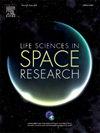Green light and nitrogen: Optimizing antioxidant production in lettuce for extraterrestrial survival
IF 2.8
3区 生物学
Q2 ASTRONOMY & ASTROPHYSICS
引用次数: 0
Abstract
Astronauts on lunar and Martian surfaces face increased health risks due to lack of Earth's protective atmosphere and magnetosphere, including higher cancer and DNA damage risks from cosmic radiation and solar wind. Antioxidant intake, sourced mainly from fresh produce, is crucial for countering these threats. Our research addressed the challenge of producing high-antioxidant vegetables in situ for Bioregenerative Life Support Systems (BLSS), focusing on optimizing growth conditions for lettuce varieties to enhance ascorbic acid synthesis.It aimed to boost ascorbic acid metabolism in lettuce by manipulating green light intensity and nitrogen levels. We tested 'youmaicai' and 'rapid' lettuce under varying green light (10 %, 20 %, 30 %) and nitrogen (2.5, 10.5, 18.5 mmol/L) conditions, assessing ascorbic acid content, total production of ascorbic acid, AsA-GSH cycle enzyme activities, and gene expression. We found optimal conditions for each variety: 10 % light and 2.5–10.5 mmol/L nitrogen for 'youmaicai', and 30 % light and 10.5–18.5 mmol/L nitrogen for 'rapid'. This research not only contributes to the understanding of how green light and nitrogen supply can be optimized to boost the nutritional quality of lettuce but also offers practical strategies for improving crop yield and quality in controlled environments.By tailoring light and nutrient conditions, it is possible to significantly enhance the vitamin C content and overall growth efficiency of plants, which has important implications for sustainable food production both on Earth and in extraterrestrial settings.

绿光和氮:优化生菜的抗氧化剂生产以适应外星生存
由于缺乏地球的保护大气层和磁层,月球和火星表面的宇航员面临着更大的健康风险,包括宇宙辐射和太阳风造成的更高的癌症和DNA损伤风险。主要来源于新鲜农产品的抗氧化剂的摄入对对抗这些威胁至关重要。我们的研究解决了为生物再生生命支持系统(BLSS)原位生产高抗氧化蔬菜的挑战,重点是优化生菜品种的生长条件,以提高抗坏血酸的合成。它旨在通过控制绿光强度和氮水平来促进生菜的抗坏血酸代谢。我们在不同的绿光(10%、20%、30%)和氮(2.5、10.5、18.5 mmol/L)条件下测试了“优麦菜”和“快速”生菜,评估了抗坏血酸含量、抗坏血酸总产量、AsA-GSH循环酶活性和基因表达。各品种的最佳栽培条件为:‘优麦菜’为10%光照和2.5 ~ 10.5 mmol/L氮肥,‘快’为30%光照和10.5 ~ 18.5 mmol/L氮肥。本研究不仅有助于了解如何优化绿光和氮供应以提高生菜的营养品质,而且为在受控环境下提高作物产量和品质提供了实用的策略。通过调整光照和营养条件,可以显著提高植物的维生素C含量和整体生长效率,这对地球和地外环境的可持续粮食生产具有重要意义。
本文章由计算机程序翻译,如有差异,请以英文原文为准。
求助全文
约1分钟内获得全文
求助全文
来源期刊

Life Sciences in Space Research
Agricultural and Biological Sciences-Agricultural and Biological Sciences (miscellaneous)
CiteScore
5.30
自引率
8.00%
发文量
69
期刊介绍:
Life Sciences in Space Research publishes high quality original research and review articles in areas previously covered by the Life Sciences section of COSPAR''s other society journal Advances in Space Research.
Life Sciences in Space Research features an editorial team of top scientists in the space radiation field and guarantees a fast turnaround time from submission to editorial decision.
 求助内容:
求助内容: 应助结果提醒方式:
应助结果提醒方式:


